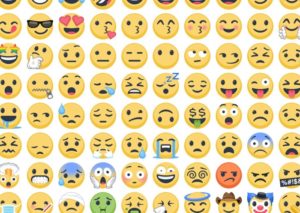Whether you are on Facebook, Twitter, Instagram, or any of the hundreds of chatrooms that exist out there to fill your lonely, pleasure-seeking whims, what I am about to describe has undoubtedly happened to you. You believe you are having a meaningful conversation, when suddenly you are hit with a barrage of ???. Yes, that’s right: emojis.
Since about 2010, emojis have been flooding our net with their teeny-tiny-ness and emotional manipulations, and they’re becoming more linguistically correct every second. How could tiny faces, miniscule drawings of birthday cake, and—God help me—cartoon eggplants wield so much power?
The original emojis were created for Japanese cell phones in 1997 and were extremely simple; they were not the storytelling wonders that they are today. If someone texted you a heart it meant they loved you. A snowman probably meant it was cold. At one point, though, someone took notice of the strength these little faces were carrying.
They also hold power in the way that they promote snobbery in the way language often will. If someone fills out a job application with an emoji after their name, it will attach an immediate judgement call with it. The same goes when applying for an apartment or a loan; not a place for emojis.
Not yet, anyway. Emojis are quickly asserting themselves as real language. How do these guys offer so much communication with a cartoon face or image? What’s more, they are actually bridging a gap in communication, and that has linguists all riled up with excitement. Have you noticed that when you are driving down the street and one of those great big speed readers flashes you a mean face, it can ruin your day? Maybe I’m unique that respect, but I know it does for me. Same deal if I get a smiley face: I’m instantly revived and pleased with myself.
It’s also fascinating that in this time of isolation, when we depend so much on online communication, emojis are assisting us in communicating when we no longer have body language to depend on. Have you ever read a text message or an email and misread the meaning behind it entirely, simply because you can’t see the person? You can’t see the expression on their face, you can’t tell if they’re feeling good with you, warm-hearted with you… Maybe they added an exclamation point, and now you are positive that they are angry and frustrated with you. The very simple solution to end all that headache of bad feelings and “I wonder if they…” is to add a smiley face at the end of an exclamation point. Not only am I not angry with you, I am actually so pleased with you, I had to accentuate it! Have a nice day! ? Then you have a nice day, feel good about yourself, perform well, and all because of one teeny emoji. That is powerful.
We have to be careful, though. Emojis do not mean the same thing in every country. For instance, if you give a thumbs up emoji in the Middle East or West Africa, it’s extremely offensive, along the lines of a middle finger. The applause emoji? Although used to give praise here in the west, in China it’s a symbol for going to bed. With someone else. The angel emoji, which is used for a symbol of innocence around here, is a symbol of death in China.
So, when our COVID-19 nightmare ends and travelling becomes a reality again, better brush up on your emoji fluency—because they aren’t always a universal language.
And whether you’re a fan of them or not doesn’t matter. They’re here to stay. ?

